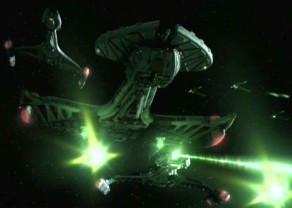The extent of the involvement of the Empire in the Dominion War
To fully appreciate the role the Klingon empire played in the Dominion War, it's important to note
that this conflict was preceded by two smaller conflicts, the war between the Empire and the
Cardassian Union on one end, and between the Empire and the Federation on the other. Both these
conflicts were inextricably linked with each other, and inevitably paved the way for the inevitable
outbreak of war with the Dominion.
The wars with Cardassia and the Federation
In 2372 the Klingon High Council received reports that the Cardassian Central Command had been
overthrown by a popular uprising, and that power had been restored to the civilian Detapa council.
High Command became convinced that the revolt had been instigated by the Dominion, and that the
Detapa council had been infiltrated by Founders. General Martok immediately called for a massive
invasion of Cardassian space to end the Changeling threat. In response to this chancellor Gowron
ordered an invasion of Cardassia in early 2372.
An advance task force of over fifty warships was dispatched to Deep Space 9, under pretext of
defending the station against a Dominion incursion. The federation, however, condemned the action
and refused to participate. In response, chancellor Gowron withdrew from the Khitomer Accords,
and proceeded with the invasion into Cardassian space, nevertheless. Simultaneously, Gowron
demanded a Federation withdrawal from the Archanis sector, and when the latter refused to comply,
he launched a fullscale
attack on Federation assets.

Meanwhile, the Empire's incursion into Cardassian space was
proceeding smoothly. The outlying Cardassian colonies were
almost immediately overwhelmed. Closer to Cardassia Prime,
the Imperial fleet were met with some resistance from the
Cardassian fleet, but still managed to break through. In a
daring rescue attempt, the Cardassian Detapa council was
spirited away from the planet, and given shelter on board
Deep Space 9. In response, the Imperial fleet attacked the
space station, but was eventually routed. In the following few
months cloaked Klingon warships waged a war of attrition on the Cardassian Union, creating a
humanitarian crisis, and paving the way for the Cardassian state's absorption into the Dominion.
In the meantime, the Federation was harboring suspicions that chancellor Gowron had been
replaced by a Founder. A covert ops team infiltrated Klingon military headquarters with the
intention to expose the Gowron impersonator, only to discover that it was Martok who was the
impersonator.
With the impostor exposed and the real Martok reinstated, a ceasefire
was called and the Khitomer
accords resigned, but by that point the Cardassians had already been in secret negotiations to join
the Dominion, and by mid2373
a massive Jem'Hadar fleet crossed the Bajoran wormhole into
Cardassian space, inflicting massive casualties on the Klingon forces, forcing chancellor Gowron to
issue a general retreat.
The Dominion War
Following shortly after the Empire's initial contact with the Jem'Hadar fleet in Cardassian space,
General Martok contacted Deep Space 9 from his vantage point near the Cardassian border, warning
them that a large contingent of Cardassian and Dominion vessels were en route to the station to
attack it. His transmission was cut short when the Dominion fleet jammed his communication.

◦ Precisely because the mass/energy of the moon was submerged into subspace, it passed
through Qo'nos with minimal interaction. Electromagnetic
interaction between the blast
wave and the ozone molecules in the atmosphere of Qo'nos resulted in the disruption of
molecular bonds in those very ozone molecules, which led to the loss of the ozone layer
itself. This also explains why space stations in the vicinity of Qo'nos were not destroyed.
As they are stationary, their mass would have been entirely in real space (just like the
mass of Qo'nos itself) and they would have sustained only slight damage as a result of
their weak interaction with the subspace energy of the shock wave. All of the denizens
and structures on Qo'nos would have suffered mild cellular and molecular damage, since
the blast wave would have passed through the entire planet with the same weak
interaction that had caused the destruction of the ozone layer. The Klingon High
Command may have conceivably concealed this information from its populace and
outsiders to keep the true extent of the disaster from becoming public knowledge.
• How could we see the shock wave moving towards us? After all, it was moving in excess of
the speed of light, so we should not have been able to see anything until the moment the
shock wave had reached us, as it would quite literally have been outracing
its own image.
◦ The scene must have been depicted from the perspective of a starship or space station
near Qo'nos. View screens on star ships and space stations are programmed to create
visible representations of objects that are not normally visible.
• Why was the shock wave a planar ring?

◦ Simply put, the shock wave could not
have been a planar ring. It must have
been a spherically-expanding
phenomenon. The planar shape of the
blast wave had to be part of the visual
algorithms of view screens on nearby star
ships and space stations. These
algorithms are designed to depict space phenomena in such a manner that the crew can
see the phenomena and react to it, without having the entire view screen obscured. If the
shock wave had to be depicted in its true, spherical shape, then nothing behind the wave
front would have been visible to the crews on nearby star ships and space stations.



